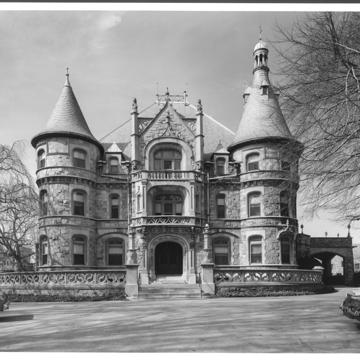You are here
Rosemont College Administration Building (“Rathalla,” Joseph Sinnott House)
The shift toward history that would characterize late-nineteenth-century Philadelphia is evidenced in the echoes of the Loire Valley that enliven this mansion by Edward Hazelhurst, a pupil of Frank Furness in the 1870s. It perhaps refers to Richard Morris Hunt's similarly massed house for James Pinchot, “Grey Towers,” in Milford ( PI10). Many small Roman Catholic colleges were established on the region's great estates that had become white elephants, while preserving the house as a trophy of institutional history.
West of Bryn Mawr, the Main Line continued as a vast bedroom suburb of the industrial city but with a greater reliance on historical forms that reflected the rise of academic historicism at the end of the century and the declining comprehension of the importance of the present. Nostalgia would rule in place of the innovations of the industrial culture. The area to the north between “Rathalla” and “Woodmont” ( MO14) marks the transition from the railroad-centered community to the automobile-centered community of the present. Almost any route passes houses that describe the regional cultural allegiance to England and colonial America, but it is notable that few modern houses continue Furness's investigation of the power of the contemporary world or the meaning of the American Revolution for the ability to create personal identity. The most important modern houses of the county are found to the east in the automobile-developed corridor around Fort Washington and Hatboro ( MO42, MO43).
Writing Credits
If SAH Archipedia has been useful to you, please consider supporting it.
SAH Archipedia tells the story of the United States through its buildings, landscapes, and cities. This freely available resource empowers the public with authoritative knowledge that deepens their understanding and appreciation of the built environment. But the Society of Architectural Historians, which created SAH Archipedia with University of Virginia Press, needs your support to maintain the high-caliber research, writing, photography, cartography, editing, design, and programming that make SAH Archipedia a trusted online resource available to all who value the history of place, heritage tourism, and learning.


